Zadie Xa
Moon Poetics and Child of Magohalmi
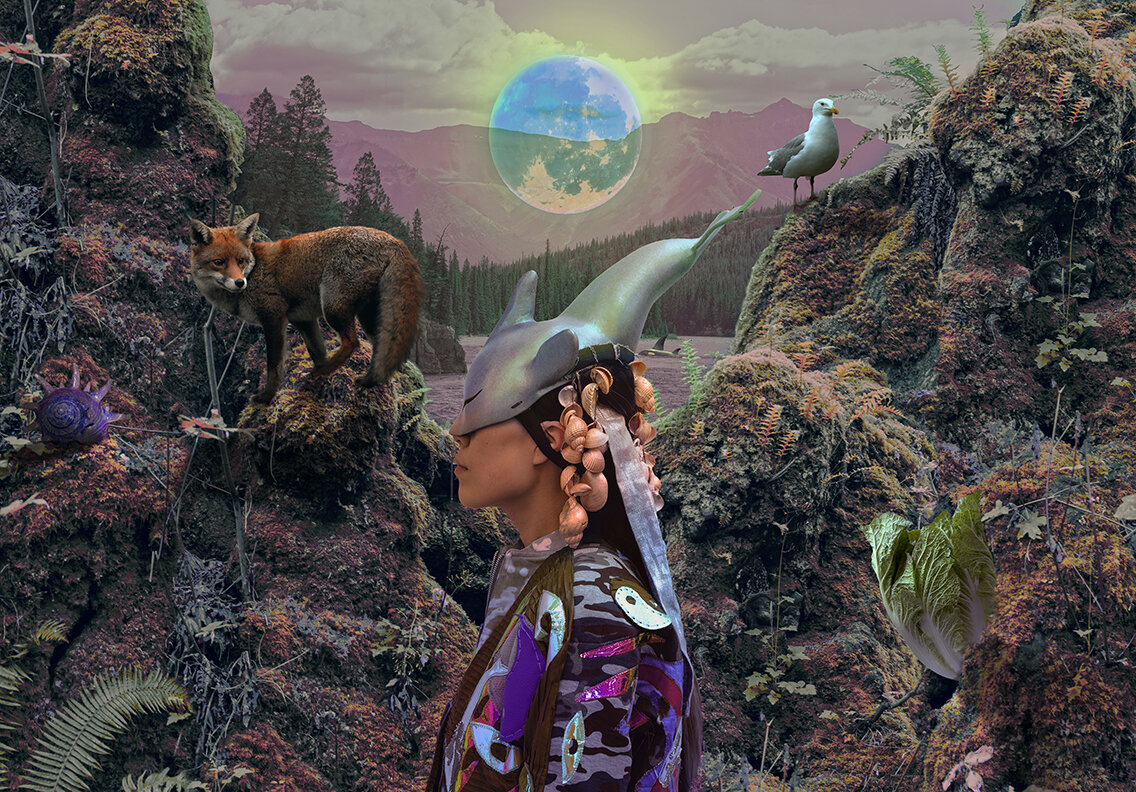
"Moon Poetics 4 Courageous Earth Critters and Dangerous Day Dreamers" 2021 Leeds Art Gallery UK. Exhibition made in collaboration with artist Benito Mayor Vallejo. Commissioned by Remai Modern and Leeds Art Gallery. Photos by Stuart Whipps.
By their nature, folktales are open projects. These stories have been retold over time from such diverse locations; they’re shaped by different communities and there can be many different interpretations. I’m interested in how histories that are created collectively are open enough to be remade, re-remembered, and shared again. I’m working on a new project where I’m doing some night gardening, and things are talking to me: plants, animals, fungi. What if I could summon the visual language or character traits of mythological creatures without relying on the language of mythology?
You were on a beach in your dream last night. The sky was hazy, bruise-purple; the water was brown like excrement. A pair of gigantic disembodied hands, rough and wrinkled like an old lady’s, busied themselves with building mountains, bridges, and fortresses out over the horizon. You stared at their dirty fingernails which started to turn black and splotchy, dorsal fins sprouting from the knuckles as the fingers dropped into the ocean and transformed underwater into a pod of orcas. You knew this without seeing them; you could understand from their echolocation that they were mourning Grandmother Mago(Halmi), a giant goddess from Korean myth, who was also the 106-year-old matriarch of a pack of Southern Killer Whales off the coast of Vancouver, who was also Princess Bari, who was also the mother of all shamans. Scattered along the beach all around you were conch shells – great exoskeletal beasts perfectly intact, a childish thrill at this discovery – you picked one up and put it to your ear and you could hear the orcas’ mourning song scintillatingly clear, as it morphed into a fox howl, and then a seagull’s screech…

"Child of Magohalmi and the Echoes of Creation", 2020. De La Warr Pavilion, Bexhill-on-Sea UK. Conceived in collaboration with Benito Mayor Vallejo. Photos by Rob Harris.
Zadie Xa’s Child of Magohalmi and the Echoes of Creation (2019) uses the scaffolding of a Korean origin story to cross thresholds of family histories and collective myth-making. It is a speculative excavation of a marginalized shamanistic goddess and many unwritten matrimonial folktales lost to time. Korean folklore, like all folklore, is a product of power relations. Who gets to tell the stories and who gets to listen? Amid a largely hetero-patriarchal imperialist model of storytelling through written word – as a kind of worlding that’s tethered to Confucian, Buddhist, and Neo-Confucian philosophies and passed down as an education rite – the cosmogonic Great Earth Mother Goddess of Korea, Mago, is an aberrant figure, bordering on the abject.
Grandmother Mago pisses and shits the world into existence; she spits out mountains, hurls dirt to form countries, gives birth to nine daughters and herself through cosmic music – and, amid the chaos of a new world order, promptly disappears. Mago performs storytelling through entering trances in order to generate non-verbal forms of knowledge. While stigmatized and written out of history, her aged body and visceral creation demonized on grounds of witchiness, even referred to pejoratively as a crone, Mago is brought back to life in the works/worlds of Xa. The cosmic matriarch is here reborn as an orca, an animal known for its capacity to communicate a more-than-human social language of feeling.
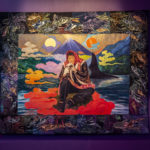
"Barnacles Under sea salt and kelp// homage to my ancestors" 2019. 330 cm x 260 cm Oil on canvas, hand dyed denim. Zadie Xa and Benito Mayor Vallejo. Photo by Keith Hunter.
Folktales are already really political in their conception. The act of telling them is like a battle, in a way – it’s two people fighting over their interpretation of the world. But they’re also shared; the Korean folktale about Jumong unifying the peninsula is the same story of the Cherokee hero Sequoyah founding the Cherokee Nation.
One of the earliest things I was proposing was this idea of a global shamanism, an alternative history that would be inclusive and hopefully could dispel these notions of white supremacy and colonial hierarchy. Then I became even more interested in some kind of a project of totalizing, inventing a different world, which involves looking at the interconnectivity of what we’re fighting for.
Lori Marino, a neuroscientist and expert in animal behavior and intelligence, particularly cephalopods, observes that “orcas are the most acoustically sophisticated animal on the planet.” It could be said that orcas perceive the world in a way that we can only imagine. “If their brains are structurally and fundamentally different, then our criteria for intelligence will almost certainly be different than theirs, too. It is just as possible they see us as acoustically obtuse and primitive – since, in comparison to them, we probably are.” In a sense, this language of whistles and clicks and pulsed calls that orcas emit underwater could be understood as a kind of cosmic music, the same that gave birth to Grandmother Mago, the same that portals orcas between worlds, their dorsal fins the physical manifestation of this magical movement.
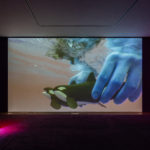
"Child of Magohalmi and the Echoes of Creation", 2020. De La Warr Pavilion, Bexhill-on-Sea UK. Conceived in collaboration with Benito Mayor Vallejo. Photos by Rob Harris.
“I was attracted to Korean mythology for two reasons, firstly because it’s a bit of a sentimental subject for me,” Xa shares with me. “Because it was my entry point into Korean culture, which I didn’t grow up with firsthand. But my work is definitely meant to speak to and hopefully add to conversations and other kinds of creation myths that other people are creating for themselves. Folk tales are like a mini world; this whole place that we’re living in is a container for all these things to coexist at the same time.”
I think that stories create spaces where people can come together to talk and where people can come together to disagree, and that’s maybe something like political resistance.
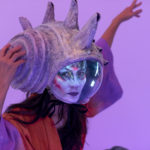
"Dream Dangerous" 2020. Live performance in collaboration with artist Benito Mayor Vallejo, performer Jia-Yu Corti and makeup artist Ophelia Liu. Curated by Victor Wang for Frieze Live 2020 Photo by Deniz Guzel.
Child of Magohalmi and the Echoes of Creation is not a world to escape into, but a hybrid of world-as-is and worlds-yet-to-be. The multimedia project – which includes a surround-sound video projection of a subaquatic environment, sculptures of dorsal fins and conch shells, and a costumed performance featuring masks and textiles made collaboratively by Xa and Benito Mayor Vallejo – has been presented in aquatically-attuned locations ranging from the De La Warr Pavilion in the English coastal town of Bexhill to the 58th Venice Biennale, a tentative city rich on myth and built upon the human-made habitat of a swamp.
Like every folktale echoing and rebirthing the emotion, trauma, and magic it holds as it’s told and retold, Child of Magohalmi and the Echoes of Creation remembers and carries forward the weight of each iteration: spoken disjunctively in gurgles, splashes, and other oceanic sounds, it is a nonlinear act of communication without words. As the work continues to amass layers of meaning with each performance, it fertilizes itself, entangling histories of Korean folklore and personal narratives as it builds a lens for understanding what’s going on around us in this world – and beyond.
I don’t think that it’s just Korean shamanism, or that it’s unique to Korean shamanism. I know that some artists who are working from indigenous approaches have a lot to contribute. I was so deeply disturbed by the fact that I had learned about Grandmother Mago a year ago before I saw the protests in Standing Rock, in North Dakota. It seems like there are certain powerful forces that are trying to stitch together these different manifestations of environmental injustice. I really feel like we need to put our whole lives on the line to address things like colonialism in order to be able to address the kind of power structures that are shaping the way we understand and live on this planet.
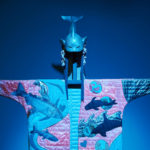
"Moon Poetics 4 Courageous Earth Critters and Dangerous Day Dreamers" 2021 Leeds Art Gallery UK. Exhibition made in collaboration with artist Benito Mayor Vallejo. Commissioned by Remai Modern and Leeds Art Gallery. Photos by Stuart Whipps.
Influenced by science and speculative fiction writers from Octavia Butler to Audre Lorde, Xa thinks of storytelling as a project of critical distance; stories can be a means of addressing, expressing, or thinking through broader social, cultural, or environmental challenges too difficult to examine head-on. But that distance can also be a kind of magic: a space of potential that recognizes our interconnected position of precarity and incites a call to action. By weaving together real and imagined worlds, can storytelling become a shared vessel for structural change? Could the figure of the shaman – for so long ostracized and relegated to the bottom rungs of (Korean) society – be a kind of ecological oracle, capable of communicating the intimate connection of the human and non-human, life and landscape, as well as the links between decolonization and environmental justice?
The Anishinaabe writer and academic Leanne Betasamosake Simpson gave the keynote speech at the 2018 Association for the Study of Literature and Environment conference in Vancouver, BC, Canada. Simpson’s keynote addressed the connections between animals and land defense, as well as the efforts of writers to decolonize the environment by taking care of the land and animals.
Moon Poetics 4 Courageous Earth Critters and Dangerous Day Dreamers (2020), Xa’s latest project, is a continuation of this premise. Shown in two locations separated by a gigantic body of water, in Leeds, England and Saskatoon, Canada – the traditional territory of Cree Peoples and the homeland of the Métis – it tells the story of animal kinship as a survival strategy for an ailing planet. It’s centralized around a disembodied character named Princess Bari – another shamanic figure from Korean folklore – who brings the dead to the afterlife. Bari, the story goes, was born to a King and Queen desiring a son in feudal Korea. They swiftly abandon the princess, who is adopted by a elderly couple, one of whom just so happens to be a shamanistic grandmother. Bari is happily raised by these elders, until one day, she learns her biological parents are very sick.
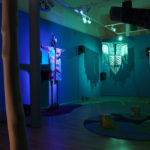
"Moon Poetics 4 Courageous Earth Critters and Dangerous Day Dreamers" 2021 Leeds Art Gallery UK. Exhibition made in collaboration with artist Benito Mayor Vallejo. Commissioned by Remai Modern and Leeds Art Gallery. Photos by Stuart Whipps.
I’ve always been interested in animals, but I’m starting to really push the limits of what it means to co-exist with or co-habit communally with wildlife as a human. A few years ago, I had a show called Parental Alienation (2017). It was this kind of kid-themed show where I included the constellations as the main characters. I know Orion, but I wouldn’t necessarily know the rabbit, so I made a story about how the rabbit was alienated by his parents. I was inventing a new story or character that kind of embodied the constellation. I’m trying to think about how we can turn the dark night sky into a commons, a site of stewardship.
In the story, Bari ultimately saves her parents by embarking on a long, arduous quest to the end of the western sky, to hunt down a life-giving elixir. The parents, overjoyed to be saved, offer her rulership over the kingdom. Bari declines: she wants to be a steward for the dead, helping their souls into the afterlife. In Moon Poetics, the viewer takes the position of Princess Bari, steered by five non-human narrators: Shell, Seagull, Fox, Cabbage, and Orca. Each animal and plant lifeform has its own version of the story to tell; that is to say the story of planetary survival, the struggle inherent in that quest, the need for cross-species collaboration in the face of the Earth’s precarious ecological future. But for Xa, the exhibition is also a container to hold many different but parallel struggles:
“Yes, I’m speaking about the ecological crisis. But there are so many different avenues of pain that we need to sort out: environmental justice is social justice is racial justice. In the midst of this deeply traumatic year, I’ve been so affected by the social justice movements like Black Lives Matter, of people marching and speaking about liberation. I was thinking a lot about that interconnectedness between humans and animal worlds, between shamanism and resistance, and ultimately, reimagine in a hopeful way different ways of being, of understanding and empathizing, that can maybe direct us to alternative situations for ourselves and the many other non-human inhabitants of our planet.”
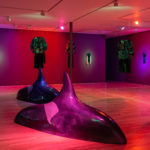
"Child of Magohalmi and the Echoes of Creation", 2020. De La Warr Pavilion, Bexhill-on-Sea UK. Conceived in collaboration with Benito Mayor Vallejo. Photos by Rob Harris.
I take a lot of comfort in that when I’m walking my dog through the woods down here and she sees a deer and it runs away. There’s this idea about the importance of learning from non-human life. But I do think our way of being in relationship to other life forms is part of the problem: this very narrow utilitarian viewpoint we have on our way of being in the world, and in relationships, and how we treat others.
I did a residency down in Brighton, and I was asked to make installations based on different artists from different eras, and in that series I sort of referenced the installation Rodin and Non-Human Collaboration. I was thinking about these two bronze sculptures of the mother and the child, and behind them there’s another bronze sculpture of another mother and child, of a woman with her hand outstretched. I was thinking about Rodin and how he works with clay to form his casts. I was thinking about the word collaborator and how I didn’t know what exactly collaborating with a non-human would look like, but I had my hands outstretched and I was communicating in a way that is sort of non-verbal, trying to read the non-human’s body.
Obviously wild animals are difficult to work with. But I think we need to think about new ways of cultivating relationships, like what is a co-creative relationship, or how can we not be so dependent on human relationships and also look to relationships we have with more non-human life-forms? How can we cultivate a more mutually beneficial relationship for all of us? There’s really a sense of urgency for me, like we’ve got to start looking at this right now if we want to have a planet.
Documented performance of Zadie Xa's "Grandmother Mago" at Art Night, London, 2019.









